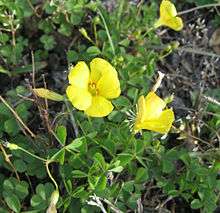Oxalis
| Oxalis | |
|---|---|
 | |
| Oxalis griffithii | |
| Scientific classification | |
| Kingdom: | Plantae |
| (unranked): | Angiosperms |
| (unranked): | Eudicots |
| (unranked): | Rosids |
| Order: | Oxalidales |
| Family: | Oxalidaceae |
| Genus: | Oxalis L. |
| Species | |
|
About 1000, see text | |
Oxalis /ˈɒksəlᵻs/[1] is by far the largest genus in the wood-sorrel family Oxalidaceae: of the approximately 900 known species in the Oxalidaceae, 800 belong here. The genus occurs throughout most of the world, except for the polar areas; species diversity is particularly rich in tropical Brazil, Mexico and South Africa.
Many of the species are known as wood sorrels (sometimes written "woodsorrels" or "wood-sorrels") as they have an acidic taste reminiscent of the unrelated sorrel proper (Rumex acetosa). Some species are called yellow sorrels or pink sorrels after the color of their flowers instead. Other species are colloquially known as false shamrocks, and some called sourgrasses. For the genus as a whole, the term oxalises is also used.
Description and ecology
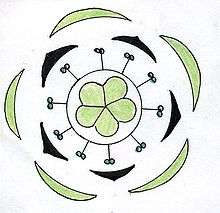
These plants are annual or perennial. The leaves are divided into three to ten or more obovate and top notched leaflets, arranged palmately with all the leaflets of roughly equal size. The majority of species have three leaflets; in these species, the leaves are superficially similar to those of some clovers. Some species exhibit rapid changes in leaf angle in response to temporarily high light intensity to decrease photoinhibition.
The flowers have five petals, which are usually fused at the base, and ten stamens. The petal color varies from white to pink, red or yellow; anthocyanins and xanthophylls may be present or absent but are generally not both present together in significant quantities, meaning that few wood-sorrels have bright orange flowers. The fruit is a small capsule containing several seeds. The roots are often tuberous and succulent, and several species also reproduce vegetatively by production of bulbils, which detach to produce new plants.
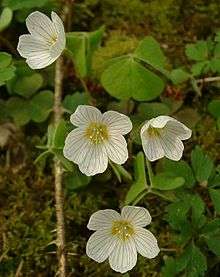

Several Oxalis species dominate the plant life in local woodland ecosystems, be it Coast Range ecoregion of the North American Pacific Northwest, or the Sydney Turpentine-Ironbark Forest in southeastern Australia where least yellow sorrel (O. exilis) is common. In the United Kingdom and neighboring Europe, common wood sorrel (O. acetosella) is the typical woodland member of this genus, forming large swaths in the typical mixed deciduous forests dominated by downy birch (Betula pubescens) and sessile oak (Quercus petraea), by sycamore maple (Acer pseudoplatanus), common bracken (Pteridium aquilinum), pedunculate oak (Q. robur) and blackberries (Rubus fruticosus agg.), or by common ash (Fraxinus excelsior), dog's mercury (Mercurialis perennis) and European rowan (Sorbus aucuparia); it is also common in woods of common juniper (Juniperus communis ssp. communis). Some species – notably Bermuda-buttercup (O. pes-caprae) and creeping woodsorrel (O. corniculata) – are pernicious, invasive weeds when escaping from cultivation outside their native ranges; the ability of most wood-sorrels to store reserve energy in their tubers makes them quite resistant to most weed control techniques.
Tuberous woodsorrels provide food for certain small herbivores – such as the Montezuma quail (Cyrtonyx montezumae). The foliage is eaten by some Lepidoptera, such as the Polyommatini pale grass blue (Pseudozizeeria maha) – which feeds on creeping wood sorrel and others – and dark grass blue (Zizeeria lysimon).
Oxalis species are susceptible to rust (Puccinia oxalidis).
Use by humans
As food
Wood sorrel (a type of oxalis) is an edible wild plant that has been consumed by humans around the world for millennia.[2] In Dr. James Duke's Handbook of Edible Weeds, he notes that the Kiowa Indian tribe chewed wood sorrel to alleviate thirst on long trips, that the Potawatomi Indians cooked it with sugar to make a dessert, the Algonquin Indians considered it an aphrodisiac, the Cherokee ate wood sorrel to alleviate mouth sores and a sore throat, and the Iroquois ate wood sorrel to help with cramps, fever and nausea.[2]
The fleshy, juicy edible tubers of the oca (O. tuberosa), have long been cultivated for food in Colombia and elsewhere in the northern Andes mountains of South America.
It is grown and sold in New Zealand as "New Zealand yam" (although not a true yam), and varieties are now available in yellow, orange, apricot, pink, as well as the traditional red-orange[3]
The leaves of scurvy-grass sorrel (O. enneaphylla) were eaten by sailors travelling around Patagonia as a source of vitamin C to avoid scurvy.
In India, creeping wood sorrel (O. corniculata) is eaten only seasonally, starting December–January. The leaves of common wood sorrel (O. acetosella) may be used to make a lemony-tasting tea when dried.
For its oxalic acid content

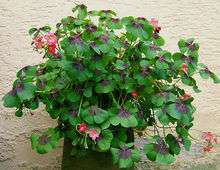
.jpg)
A characteristic of members of this genus is that they contain oxalic acid (whose name references the genus), giving the leaves and flowers a sour taste which can make them refreshing to chew.[4] In very large amounts, oxalic acid may be considered slightly toxic, interfering with proper digestion and kidney function. However, oxalic acid is also present in more commonly consumed foods such as spinach, broccoli, brussel sprouts, grapefruit, chives, and rhubarb, among many others.[5] General scientific consensus seems to be that the risk of sheer toxicity, actual poisoning from oxalic acid, in persons with normal kidney function is "wildly unlikely".[6]
While any oxalic acid-containing plant, such as Oxalis, is toxic to humans in some dosage,[7] the U.S. National Institutes of Health note that oxalic acid is present in many foodstuffs found in the supermarket and its toxicity is generally of little or no consequence for people who eat a variety of foods.[8]
In the past, it was a practice to extract crystals of calcium oxalate for use in treating diseases and as a salt called sal acetosella or "sorrel salt" (also known as "salt of lemon"). Growing oca tuber root caps are covered in a fluorescent slush rich in harmaline and harmine which apparently suppresses pests; this phenomenon has been studied to some extent at the Colorado State University.[9] Creeping wood sorrel and perhaps other species are apparently hyperaccumulators of copper. The Ming Dynasty text Precious Secrets of the Realm of the King of Xin from 1421 describes how O. corniculata can be used to locate copper deposits as well as for geobotanical prospecting. It thus ought to have some potential for phytoremediation of contaminated soils.
As ornamental plants
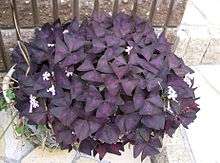
Several species are grown as pot plants or as ornamental plants in gardens, for example, O. versicolor.
Oxalis flowers range in colour from whites to yellows, peaches, pinks, or multi-coloured flowers.[10]
Some varieties have double flowers, for example the double form of O. compressus. Some varieties are grown for their foliage, such as the dark purple-leaved O. triangularis.
Species with four regular leaflets – in particular O. tetraphylla (four-leaved pink-sorrel) – are sometimes misleadingly sold as "four-leaf clover", taking advantage of the mystical status of four-leaf clover.
Selected species
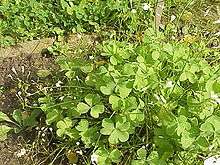

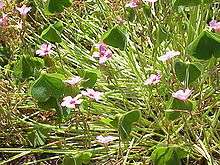

_in_Hyderabad%2C_AP_W_IMG_9725.jpg)

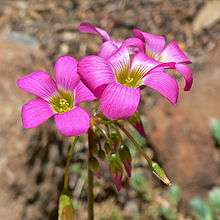
_2.jpg)
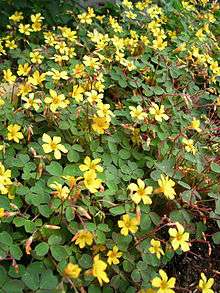
- Oxalis acetosella – common wood sorrel, stabwort
- Oxalis adenophylla – Chilean oxalis, silver shamrock
- Oxalis albicans – hairy woodsorrel, white oxalis, radishroot woodsorrel, radishroot yellow-sorrel, California yellow-sorrel
- Oxalis albicans var. pilosa formerly O. pilosa [13]
- Oxalis alpina – alpine sorrel
- Oxalis ambigua
- Oxalis amblyosepala
- Oxalis amplifolia now considered O. drummondii [13]
- Oxalis arborea Hort.
- Oxalis arenia
- Oxalis articulata Savign. – pink-sorrel
- Oxalis articulata ssp. rubra (St.Hil.) Lourteig
- Oxalis ausensis
- Oxalis barrelieri – lavender sorrel
- Oxalis bowiei – Bowie's wood-sorrel, Cape shamrock
- Oxalis brasiliensis
- Oxalis bulbocastanum
- Oxalis caerulea – blue woodsorrel
- Oxalis caprina
- Oxalis carnosa
- Oxalis callosa
- Oxalis chnoodes
- Oxalis commutata
- Oxalis compressa
- Oxalis comptonii
- Oxalis convexula
- Oxalis corymbosa
- Oxalis corniculata – creeping wood sorrel, procumbent yellow-sorrel, sleeping beauty, chichoda bhaji (India)
- Oxalis crassipes – white wood sorrel
- Oxalis debilis Kunth
- Oxalis debilis var. corymbosa (DC.) Lourteig – large-flowered pink-sorrel (Synonym : O. corymbosa)
- Oxalis decaphylla – ten-leaved pink-sorrel, tenleaf wood sorrel
- Oxalis dehradunensis
- Oxalis depressa
- Oxalis dichondrifolia – peonyleaf wood sorrel
- Oxalis dillenii Jacquin – southern yellow woodsorrel, Dillen's woodsorrel, Sussex yellow-sorrel
- Oxalis drummondii – Drummond's woodsorrel, chevron oxalis
- Oxalis ecuadorensis
- Oxalis eggersii – Egger's wood-sorrel
- Oxalis engleriana
- Oxalis enneaphylla – scurvy-grass sorrel
- Oxalis exilis – least yellow-sorrel
- Oxalis fabaefolia
- Oxalis flava
- Oxalis florida
- Oxalis fourcadei Salter
- Oxalis frutescens – shrubby wood-sorrel
- Oxalis frutescens ssp. angustifolia
- Oxalis giftbergensis
- Oxalis gigantea
- Oxalis glabra
- Oxalis goniorhiza
- Oxalis grandis – great yellow-sorrel, large yellow woodsorrel
- Oxalis grayi is now considered O. decaphylla [13]
- Oxalis griffithii Edgew. & Hook.f.
- Oxalis hedysaroides – fire fern
- Oxalis hirta – hairy sorrel
- Oxalis hygrophila
- Oxalis illinoensis – Illinois wood-sorrel
- Oxalis inaequalis
- Oxalis incarnata L. – pale pink-sorrel
- Oxalis intermedia – West Indian wood-sorrel
- Oxalis laciniata
- Oxalis lasiandra – Mexican shamrock
- Oxalis latifolia Kunth – garden pink-sorrel
- Oxalis livida
- Oxalis luederitzii
- Oxalis luteola Jacq.
- Oxalis macrocarpa
- Oxalis magellanica G.Forst.
- Oxalis magnifica Kunth
- Oxalis mallobolva
- Oxalis massoniana
- Oxalis megalorrhiza – fleshy yellow-sorrel
- Oxalis meisneri
- Oxalis melanosticta
- Oxalis metcalfei now considered O. alpina [13]
- Oxalis micrantha
- Oxalis montana – mountain woodsorrel, white woodsorrel
- Oxalis monticola now considered O. alpina [13]
- Oxalis namaquana
- Oxalis natans
- Oxalis nelsonii – Nelson's sorrel
- Oxalis nigrescens A.St.-Hil.
- Oxalis norlindiana
- Oxalis obliquifolia
- Oxalis obtusa
- Oxalis oculifera
- Oxalis oligophylla
- Oxalis oregana – redwood sorrel, Oregon sorrel
- Oxalis oreophila
- Oxalis ortgiesii Regel
- Oxalis palmifrons
- Oxalis pardalis
- Oxalis pennelliana
- Oxalis perennans
- Oxalis peridicaria (= O. lobata)
- Oxalis pes-caprae – Bermuda-buttercup, African wood-sorrel, Bermuda sorrel, buttercup oxalis, Cape sorrel, English weed, soursob, "goat's-foot", "sourgrass", soursop (not to be confused with the fruit of that name)
- Oxalis pilosa see O. albicans [13]
- Oxalis polyphylla
- Oxalis polyphylla heptaphylla
- Oxalis priceae – tufted yellow-sorrel
- Oxalis puberula
- Oxalis purpurea L. – purple wood-sorrel
- Oxalis radicosa – dwarf woodsorrel
- Oxalis regnellii – false shamrock, purple shamrock, love plant
- Oxalis repens Thumb.
- Oxalis rosea Feuillée ex Jacq. – annual pink-sorrel
- Oxalis rubens
- Oxalis rubra A.St.-Hil. – red wood-sorrel
- Oxalis rufescens
- Oxalis rugeliana – coamo
- Oxalis schaeferi
- Oxalis spiralis – spiral sorrel, volcanic sorrel, velvet oxalis
- Oxalis squamata
- Oxalis stricta [14] – common yellow woodsorrel, common yellow oxalis, upright yellow-sorrel, lemon clover, "pickle plant", "sourgrass, "yellow woodsorrel"
- Oxalis suksdorfii – western yellow woodsorrel, western yellow oxalis
- Oxalis tenuifolia
- Oxalis texana
- Oxalis tetraphylla – four-leaved pink-sorrel, four-leaf sorrel, Iron Cross oxalis, "lucky clover"
- Oxalis thompsoniae
- Oxalis tomentosa
- Oxalis triangularis – threeleaf purple shamrock
- Oxalis trilliifolia – great oxalis, threeleaf woodsorrel
- Oxalis tuberosa – oca, oka, New Zealand yam
- Oxalis valdiviensis – Chilean yellow-sorrel
- Oxalis versicolor candycane sorrel
- Oxalis violacea – violet wood-sorrel
- Oxalis vulcanicola – Oxalis spiralis ssp. volcanicola – volcanic sorrel or velvet oxalis.
- Oxalis zeekoevleyensis
References
- ↑ Sunset Western Garden Book, 1995:606–607
- 1 2 https://books.google.com/books?id=rVrteo-8cI0C Handbook of Edible Weeds By Dr. James A. Duke, pp. 140-141
- ↑ http://www.vegetables.co.nz/select_a_vegetable/yams.asp
- ↑ Łuczaj (2008)
- ↑ http://www.nal.usda.gov/fnic/foodcomp/Data/Other/oxalic.html "Oxalic Acid Content of Selected Vegetables"
- ↑ http://oxalicacidinfo.com/ "Sheer toxicity – actual poisoning – from ingested oxalic acid is wildly unlikely. The only foodstuff that contains oxalic acid at concentrations high enough to be an actual toxicity risk is the leaves – not the stalks, which is what one normally eats – of the rhubarb plant. (And you'd need to eat an estimated 11 pounds (5kg) of rhubarb leaves at one sitting for a lethal dose, though you'd be pretty sick with rather less.)"
- ↑ MedlinePlus Encyclopedia Oxalic acid poisoning
- ↑ http://dietary-supplements.info.nih.gov/factsheets/calcium.asp "Other components in food: phytic acid and oxalic acid, found naturally in some plants, bind to calcium and can inhibit its absorption. Foods with high levels of oxalic acid include spinach, collard greens, sweet potatoes, rhubarb, and beans. Among the foods high in phytic acid are fiber-containing whole-grain products and wheat bran, beans, seeds, nuts, and soy isolates. The extent to which these compounds affect calcium absorption varies. Research shows, for example, that eating spinach and milk at the same time reduces absorption of the calcium in milk. In contrast, wheat products (with the exception of wheat bran) do not appear to have a negative impact on calcium absorption. For people who eat a variety of foods, these interactions probably have little or no nutritional consequence and, furthermore, are accounted for in the overall calcium DRIs, which take absorption into account."
- ↑ Bais et al. (2002, 2003)
- ↑ http://www.stuff.co.nz/nelson-mail/lifestyle-entertainment/lifestyle/home-and-garden/2495449/A-daring-passion
- ↑ USDA Plant Database
- ↑ Again: Taxonomy Of Yellow-Flowered Caulescent Oxalis (Oxalidaceae) In Eastern North America J. Bot. Res. Inst. Texas 3(2): 727 – 738. 2009
- 1 2 3 4 5 6 Welcome to the PLANTS Database | USDA PLANTS
- ↑ Welcome to the PLANTS Database | USDA PLANTS
Further reading
- Bais, Harsh Pal; Park, Sang-Wook; Stermitz, Frank R.; Halligan, Kathleen M. & Vivanco, Jorge M. (2002): Exudation of fluorescent β-carbolines from Oxalis tuberosa L. roots. Phytochemistry 61(5): 539–543. doi:10.1016/S0031-9422(02)00235-2 PDF fulltext
- Bais, Harsh Pal; Vepachedu, Ramarao & Vivanco, Jorge M. (2003): Root specific elicitation and exudation of fluorescent β-carbolines in transformed root cultures of Oxalis tuberosa. Plant Physiology and Biochemistry 41(4): 345-353. doi:10.1016/S0981-9428(03)00029-9 Preprint PDF fulltext
- Łuczaj, Łukasz (2008): Archival data on wild food plants used in Poland in 1948. Journal of Ethnobiology and Ethnomedicine 4: 4. doi:10.1186/1746-4269-4-4 PDF fulltext
External links
| Wikimedia Commons has media related to Oxalis. |
- Plant Profile for Oxalis – USDA Plant Database
- Glossary of Archaic Chemical Terms: Sorrel
- Pictures and Information of Oxalis adenophylla in Chile
- Pacific Bulb Society website – with many references to Oxalis species



